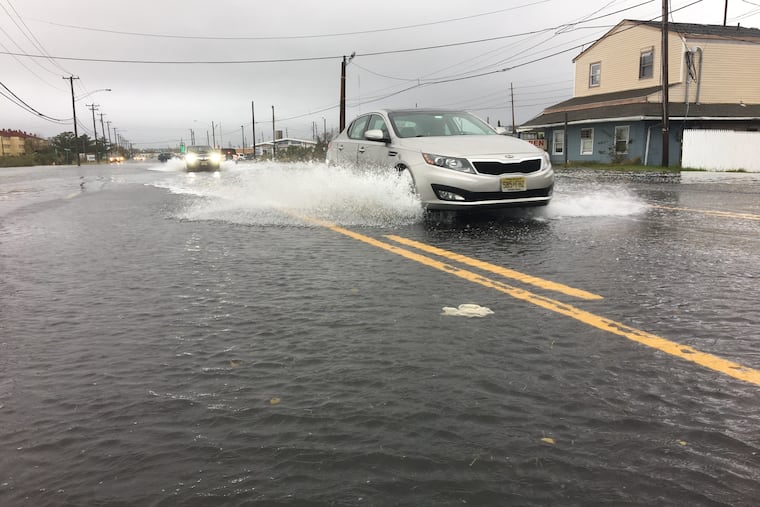Climate change blamed for grim outlook on Jersey Shore flooding, federal report says
The National Oceanic and Atmospheric Administration released a report on tidal flooding for the U.S. and the news was not good for the New Jersey Shore.

The trend persists, and it’s not good for New Jersey: Coastal towns continue to see increased high-tide flooding, inundating streets and basements — the result of sea level rise, the National Oceanic and Atmospheric Administration (NOAA) said during a Wednesday teleconference.
In 2018, the number of high-tide flooding days tied the U.S. record set in 2015, according to NOAA’s fifth annual report on coastal high-tide flooding, also known as “nuisance” or “sunny day" flooding.
NOAA’s definition of high-tide flooding is when water levels measured by tide gauges exceed national flooding thresholds. As the sea level rises, it no longer takes a strong storm or a hurricane to cause coastal high-tide flooding in New Jersey’s oceanfront communities, back bays, and Delaware Bayshore region. Flooding can occur on clear, sunny days.
Sites in the Northeastern United States were hardest hit in the nation in 2018, with a median of 10 days of high-tide flooding, meaning that half had more than 10 days. Nationwide, the median number of high-tide flooding days was five.
The numbers do not necessarily reflect all flooding from nor’easters and other storms, just flooding during high tides that exceeded certain levels. Decades ago, flooding typically occurred only during powerful storms. Because of sea rise, flooding can now be caused by a steady breeze or change in coastal currents during high tides.
Locally, Atlantic City saw nine days of high-tide flooding in 2018, according to NOAA. The record for Atlantic City was 22 days in 2017. However, those numbers could look small by 2050, when high-tide flood days are expected to rise to 65 to 155 days.
Philadelphia saw eight days of high-tide flooding last year. The city sits at the confluence of the Schuylkill and the Delaware River, both impacted by tides from the Delaware Estuary. By 2050, NOAA forecasts there will be 30 to 105 days of flooding.
William Sweet, an oceanographer with NOAA’s Center for Operational Oceanographic Products and Services, put the biggest driver squarely on climate change.
“It’s really starting to take its toll,” Sweet said of sea level rise.
High-tide flooding is not benign. It causes closures, overwhelms storm drains, and compromises infrastructure, scientists say.
As sea levels rise, storm-water systems can no longer handle the flow. Sweet said sea levels are rising about one inch every eight years. Flooding fills storm-water pipes, preventing rainwater from going into storm drains. As a result, the water floods streets and neighborhoods. Flooding also causes sewer systems to overflow into waterways.
Coastal flooding is increasing in frequency, depth, and extent in many areas of the U.S. due to ongoing increases in sea level. In New Jersey, sea level is impacted by both higher ocean levels because of melting ice caps and sinking land, known as subsidence.
The NOAA report was written by scientists who examined existing flood thresholds established by the National Weather Service. They looked for patterns in those thresholds based on tidal ranges as a way to create a standard that could be applied nationwide for measuring minor high-tide flooding, as well as moderate and major flooding in locations.
Minor, moderate, and major coastal flooding typically begin at about 0.5 meters (1 foot, 7 inches), 0.8 meters (2-foot-7), and 1.2 meters (3-foot-11), respectively, above multi-year averages of daily highest water levels.
NOAA’s estimates are taken from a range of lower and higher continuation of carbon emissions. It also looked at influences of El Niño and La Niña years, which can impact weather.
High-tide flooding will become more chronic over the next few decades, according to the NOAA forecast. The goal of the report is to give communities information on risks they face to prepare for more flooding.
NOAA is certainly not alone in signaling warnings about the impact of sea level rise on coastal areas. In February, the First Street Foundation released a study on the impact of climate change on property values, singling out multiple New Jersey Shore communities as expected to be impacted. It found that though property values along the Shore certainly are increasing, there is a “relative” erosion of property values.
In other words, homes would be selling for more if not for shrinking shorelines, flooding, and storm surges associated with sea level rise, caused mainly by climate change. For example, a home that might have sold for $800,000 without those issues instead might sell for $650,000.